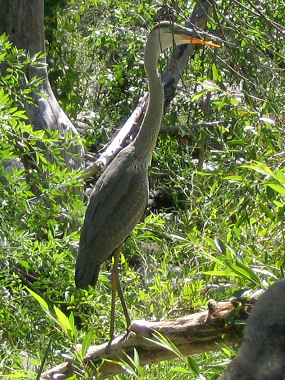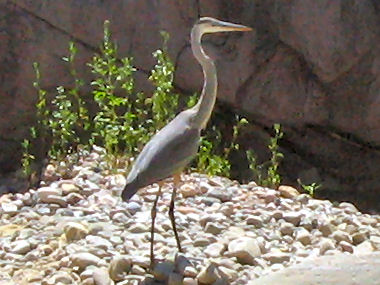The Great Blue Heron is a long-legged
wading bird and the largest North American heron. The bi rd
stands 4 feet tall and has a wingspan of 6 feet. It is mainly grayish in
coloration with blue-gray wings and back, whitish underparts, a white
head with a dark streak and a pale or yellowish bill. The bird has one
of the widest ranges of any North American heron and are found in
riparian habitats in the desert, including rivers, ponds and marshes. rd
stands 4 feet tall and has a wingspan of 6 feet. It is mainly grayish in
coloration with blue-gray wings and back, whitish underparts, a white
head with a dark streak and a pale or yellowish bill. The bird has one
of the widest ranges of any North American heron and are found in
riparian habitats in the desert, including rivers, ponds and marshes.
|
Herons are often confused with
cranes. They can be distinguished by the fact that the herons fly
with their necks folded back, while cranes fly with it straight
out. |
The Great Blue Heron often feeds while standing still
or slowly wading in shallow water. It eats fish, lizards, frogs,
crawfish, rodents, and insects. The heron usually catches food by
impaling the prey on its long, sharp bill. It then tosses the dead prey
into the air, and catches it with its mouth. Most Great Blues nest in
colonies in tall trees; their nest is a large, flat, well made platform
of interwoven sticks lined with twigs and leaves. Females lay 3-7 pale
green eggs in each clutch which takes 28 days to incubate. Both male and
female herons tend the young after they hatch. The chicks are usually
able to leave the nest after about two months.
 |

